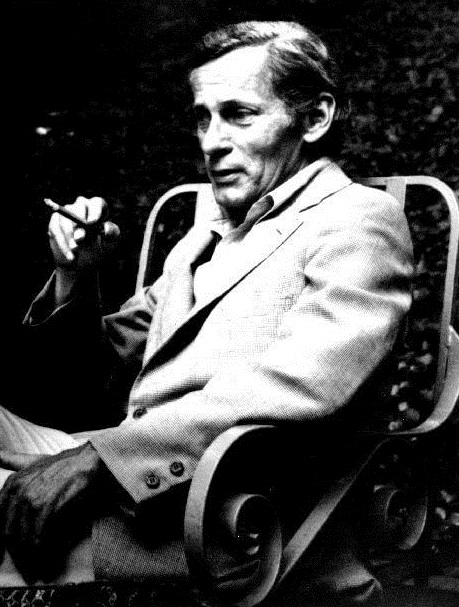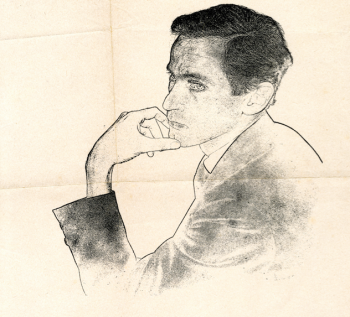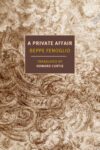The following is from the latest issue of the Full Stop Quarterly. You can purchase the issue here or subscribe at our Patreon page.
Criticism is the art we need most today. But not, don’t you see? not the “if I’d done it myself . . .” Yes a, a disciplined nostalgia, disciplined recognitions but not, no, listen, what is the favor? Why did you come here?
—William Gaddis, The Recognitions
Accounts of commercial music often tend to forget the enormous historical role performed by the player piano, but William Gaddis in his five decades of writing life never once forgot. From a contemporary view, the idea of a self-playing instrument enjoying such heights of popularity in its time hardly seems likely. The player comes off as too fanciful, too much a novelty. Like someone has tried, after the fact, to reproduce digital methods of storage and retrieval through analog means. What allure it still claims today is largely consigned to the realm of gimmick. Nevertheless, this system of pedal, pneumatic tubes, and clockwork gears all set to order by a spooled roll of intricately perforated paper was hugely formative in the early culture of the twentieth century, not least as regards the introduction of music to the home. Gaddis tells us that players accounted for a full sixty-five percent of total piano production in 1916. That is: 200 thousand player pianos manufactured in one year alone, with an attendant consumer market for rolls cut from both classical and popular tunes.
One of the joys of reading William Gaddis is his insistence on the materiality of paper—whether that be in the form of paper money, the printed page, or the counterfeiter Frank Sinisterra of The Recognitions, who arrives in the novel’s early action with a boutonnière of paper petals stuck into his shirtfront. Playacting as a surgeon to secure board on the ocean liner Purdue Victory, with “a set of false papers he had printed himself,” Mr. Sinisterra will go on to messily botch an appendectomy to fatal effect and so incite the plot’s principal action. In 1975’s J R too, paper proliferates, unaccountably. Indeed, J R may well lay claim to being the great book of junk mail, by the end of which eleven-year-old boy J R Vansant has established a “paper empire” with his multimillion dollar J R Family of Corporations. It’s hard not to see in Gaddis’s paper the dimension of a growing virtuality. Everywhere paper is the condition of fraud, forgery, misunderstanding, the calumnies of journalism as well as the then-nascent field of public relations—this at the same time that paper constitutes the medium in which Gaddis carries out his own work. Incidentally, the paper of a piano roll can run up to thirty yards in length, and its tempo is figured in units of feet per second.
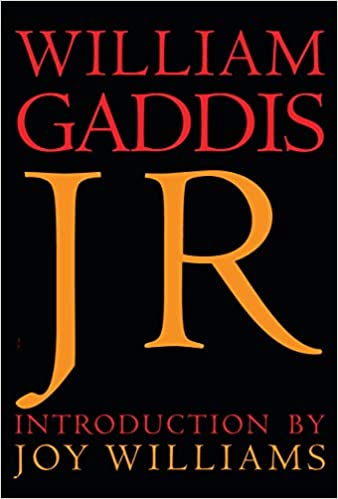
This autumn, both The Recognitions and J R will be reissued in paperback edition by NYRB Classics, newly introduced by Tom McCarthy and Joy Williams, respectively.
Throughout his career as a writer of both fiction and, more intermittently, nonfiction, William Gaddis wrestled with the completion of a planned social history of the player piano. After his death, the project would survive in the form of a “Player Piano Chronology to 1929,” consisting of innumerable notes, newspaper clippings, drafts of pages, as well as a concluded introduction to what would have become “Agapē Agape: The Secret History of the Player Piano” (a planned volume sharing its name with Gaddis’s final book, completed in 1998, though the subtitle would eventually be dropped). If the quality of an artistic obsession can be figured by its longevity and consistency, Gaddis’s is remarkable among his or any generational cohort. He both begins and ends his writing with a critical eye set unflinchingly towards the player piano, and the insights garnered from studied meditation on this piece of technology would be incorporated into every one of his novels. It remains a locus of both constant, beleaguered attention and considerable productive energy. It also happens to be the site of Gaddis’s most spectacular failure. For all his efforts, Gaddis’s projected history was never completed in the manner originally conceived. Rather, this history exists only in a fragmentary, suggestive form appearing in the margins of what work he was able, in his lifetime, to realize.
In consideration of that work, particularly as regards the two novels now once more in print, the player piano project offers perhaps the most immediate access to Gaddis’s compositional strategies. The common elements at play here subsist not only as pertinent to theme or focus, but method too. Gaddis’s four decades spent incrementally collating non-fiction materials reprise the manner in which he first put together The Recognitions during the late forties and early fifties—a period encompassing his global travels, tenure in Greenwich Village as a privileged bohemian, and final suburban isolation on Long Island, where he at last finished the book. J R too was put together in piecemeal fashion, beginning with notes and scraps of dialog painstakingly written over a period of nearly twenty years. In that light, Gaddis’s lifelong research project represents, in part, his apprenticeship in a form of writing wholly his own, one stitched out of historical anecdotes, turns of phrase cribbed from his own as well as overheard conversations, and punctuated in the author’s intermittent rhapsodic asides.
Gaddis broke ground on his player piano project with his very first national magazine publication. The short 1951 article “Stop Player. Joke No. 5” appeared initially in the pages of The Atlantic Monthly. Its publication predates that of Kurt Vonnegut’s debut Player Piano by one year and that of The Recognitions by four. Already we see the young writer scandalized by a piece of technology that could neatly render music via a series of punctured holes. Gaddis characterizes the player piano experience here as one of “the opportunity to participate in something which asked little understanding; the pleasure of creating without work, practice, or the taking of time; and the manifestation of talent where there was none.”
In his last novel, Agapē Agape, Gaddis wrote of his unnamed narrator’s deathbed struggle to complete a volume on “that all-or-none paper roll with the holes in it . . . if ever the daughters of music were brought low.”
All of this is most floridly expressed in the “Agapē Agape” introduction, collected in Gaddis’s non-fiction book The Rush for Second Place, also published posthumously. There we are presented with the all-embracing, comprehensive nature of that which Gaddis’s efforts would plumb. The “social history” aspect of the player piano volume is meant seriously, and it’s clear that Gaddis understood this instrument not only according to its marketed purpose, but likewise as an expression in concentrated form of the market society from which it emerged. As such, the player piano opens considerable inroads onto analysis of those same social dynamics of which it is a symptom, that “orgy of fragmented talents seeking after the useful.” Frank Woolworth, John D. Rockefeller, Horatio Algier, Mary Baker Eddy, and William James are each named culprits, indications of a coming culture of unbridled pragmatism and ends-directed reason, all these figures bent in their own individual way towards the progressive obviation of failure: “Analysis, management, prediction and control, the elimination of failure through programmed organization, the player emerged as a distillation of the goals that had surrounded its gestation . . .”
And it is exactly the eradication of failure—“invention” as we’re told here, “eliminating the very possibility of failure as a condition for success precisely in the arts where one’s best is never good enough”—that represents, for Gaddis, the player piano’s most fundamental scandal. Failure, so considered, is not an exterior menace to the completion of the player piano history. Rather, following the logic Gaddis outlines, failure is immanent to artistic merit, constitutive of success at the same time that it reasserts itself in a practice for which one’s best is never good enough. With the player piano, one need no longer be a skilled musician to enjoy music in the home. (The gramophone too fulfills an analogous function, during a roughly contemporaneous period.) For an artist who would go on to spend his entire career writing about standardization, counterfeit, imposture, and the downward adjustment of expectation in postwar society, the player’s exemplarity was evident from the very start.
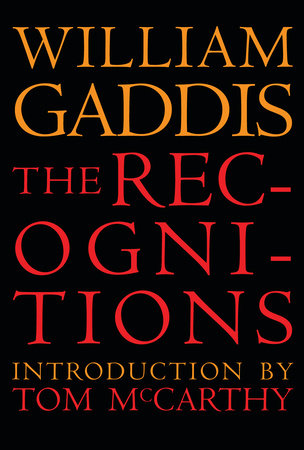
1955’s The Recognitions takes a cue from this example to brilliant effect. Structured as a coded retelling of the Faust narrative, The Recognitions details the protagonist Wyatt Gwyon’s adventures in art crime, and instances of real-world historical forgery redouble on almost every one of the book’s 956 pages. A frustrated painter, Wyatt is approached by the diabolical business magnate (and improbably named) Recktall Brown to produce artwork in the style of Northern Renaissance masters so that these works might be “discovered” and “verified” by Brown’s own experts as originals. What follows is a story of syncretism and deception, embracing the whole of commerce and the arts, urban and rural life, as well as the deep-mythic structure of Christianity itself.
Gaddis prepares his own case almost legalistically, cribbing extensively from examples, pursuing imaginative scenarios to their nth instance, fueled all the while by a sturdy Protestant outrage against things easily had. How is it possible, amid an image-saturated society, to grasp matters according to their first principles? The Recognitions is foremost a narrative of this question’s rigorous working over, and it conveys an anxious relation towards originality. Indeed, it is the paradox of origins here that they flourish and multiply. As Wyatt discovers, uncovering one imitation never fails to reveal another, prior in both logic and time. The German title of the novel, translated by Marcus Ingendaay, might plausibly be put back into English as The Falsification of the World, and it is tempting to read in this not only the falsification of something supposed as cosmologically original, but an understanding of falsehood as creative power—the masked guise by which the new is produced, alchemically, within the body of the old.
Nonetheless, Wyatt remains able, at the beginning of The Recognitions’ denouement, to “thank God there was gold to forge!” This though he has been, throughout the course of the book, so often subjected to the non-beneficent will of those who would threaten his dignity as a creator.
On this front, Gaddis’s early intimation would prove prescient. In the world that J R first detailed upon its publication in 1975, the forces of administered society—which Gaddis previously glimpsed only in their precocious form—now hold full sway. The junior high school students of the novel are taught their lessons by closed-circuit television. An overlapping system of corporate and brokerage firms steer the new global, heavily financialized economy against the same disorder for which that system’s own machinations are responsible. Everywhere mean consideration and noise militate against “the self who could do more,” a phrase which recurs in all five of Gaddis’s novels and expresses neatly the pride of place that he allots to individual responsibility and potential.
If the player piano represents an early instance of culture’s commoditization, the tendency can now be seen to have become well-advanced. Self-control, much touted, cedes priority to the system’s control of cybernetics. “Read Wiener on communication,” as the character Jack Gibbs says, “more complicated the message more God damned chance for errors . . .” Norbert Wiener’s The Human Use of Human Beings was hugely influential in Gaddis’s research for the novel, with both works sharing emphases on feedback, information, and the coming action soon to be exacted by automation upon human communities. The self who could do more is no longer self-determined, but instead functionalized, fitted into the social fabric as part to whole. “The body engine concept” is, in the novel, one proposed name for a curriculum in sexual education that “should help eliminate the offensive human element.” Written almost entirely in unattributed dialog, J R brings administration’s spoken element to the fore, with all its jargon and hypercorrect double speech. In this way, it presents a vision in which communication’s complicated, error-prone form overrides any consideration of content or value. Herein lies the novel’s farce.
What unites The Recognitions and J R more than anything is an overwhelming sense of something lost amid the throes of technological advance, an abiding attendance to that elimination of failure which is modernization’s constant condition. Early in The Recognitions, Wyatt’s father Reverend Gwyon reflects on a passage from the Scottish poet Andrew Lang’s Magic and Religion, recounted in the novel nearly verbatim, as the Reverend thinks back on “a time before death entered the world, before accident, before magic, and before magic despaired, to become religion.” Such too is Gaddis’s account of history—the plenary and substantial thought represented by pre-magical consciousness acceding to a magic that is in turn rationalized into religious doctrine, itself displaced in a secular era. Novelty first apes and then hollows out the body of tradition, all before instituting a new regime. This march of concepts reflects almost point-for-point the sociologist Max Weber’s diagnosis of modernity’s “disenchantment.” In The Protestant Ethic and the Spirit of Capitalism, Weber writes of the sober nature of bourgeois economic calculation, having its basis in the redirection of initially religious impulses (e.g., Calvinism’s twin ideologies of election and good works) into the profane, commercial sphere. Famously consequent to this is Weber’s supposed “iron cage of reason”: a world in which formal rationality has embraced the whole of society through means of bureaucratization, mechanization, and the specialization of all fields theoretical and practical. As J R’s Jack Gibbs drunkenly intones: “God damned Protestant ethic can’t escape it have to redeem it . . .”
We first meet Jack Gibbs as a physics teacher at J R Vansant’s junior high school. J R’s plot and structure are hydra-headed, but Gibbs forms one of the major foci around which the book is organized. The plot through line uniting J R’s various and scattered episodes deals with the titular character, a sixth-grade schoolboy who, beginning from a modest trade in penny stocks and free items acquired from a series of mail-order catalogs, is able to build his on-paper fortune into a sizeable corporate conglomerate. Gibbs meanwhile has arrived at the school after having years ago worked for a company named General Roll, which first began as a manufacturer of player piano rolls and has, by the time of the novel’s action, moved on to computer punch cards. General Roll’s manager-owner Norman Angel describes Gibbs as “the smartest man I ever met.” Here’s Norman further:
A while after he left there I’d look in book stores when I passed one to see if there was a book with his name on it, he said that’s what he was doing writing a book. If you ever heard him talk about these ideas he had about random patterns and mechanizing you name it but if he ever wrote that book, I sure never saw it . . .
This unwritten book makes an appearance in J R, bearing features and even quoting directly from Gaddis’s own “Agapē Agape.” Gibbs says of the project that it’s “about order and disorder more of a, sort of a social history of mechanization and the arts, the destructive elements . . .” This method of inserting himself into his fictional creations is common throughout Gaddis’s books. Elements of the author’s abortive Civil War play Once at Antietam appear in similar form in the novel A Frolic of His Own, for instance. In The Recognitions, Wyatt Gwyon also at times assumes a resemblance with his author, but it is to Gibbs that Gaddis’s relation is least mediated. As Jack Gibbs is introduced to the reader, he’s an erstwhile writer, demoralized, too often drunk thanks to the miserable circumstances of his divorce. However, after winning the double on a horse race, well into the novel, Gibbs at last has wherewithal sufficient to return to his manuscript after years of neglect.
When it comes to detailing the material circumstances of artmaking, Gaddis never fails to appear on the page at both his most personal and most poisonous. Seated in his uptown apartment (which has, through an unlikely turn, been transformed into an office for the J R Family of Corporations), Gibbs reads aloud from his previously abandoned manuscript, harried all the while by visitors in and out, package deliveries, telephone calls. He inveighs against the work’s supposed difficulty, interspersing his reading aloud with the periodic “anything hard about that?” Huge segments of the “Agapē Agape” introductory portion are interpolated word-for-word, and Gaddis too maintains a margin of irony as concerns the abstruse nature of his youthful efforts, with Jack Gibbs exasperatedly describing the book’s topic:
Shoot the God damned pianist what it’s about just told you, player piano play by itself get to shoot the pianist just read it God damn it says it right here, here where invention was eliminating the very possibility of failure as condition for success precisely in the God damned arts there, says it right there.
By the end, Gibbs finds it impossible to bring off his social history of music’s automation (as well as, more expansively, the social disorder attendant with commercial society in general) from amidst that disorder’s teeming epicenter. Like Gaddis, who first began research on the player piano well before the completion of J R, Gibbs is bested, somehow, perhaps by the sheer weight and energy of his own efforts. The question, once so live, no longer makes any sense to him. As Gaddis says of his own work on the player, writing in 1992 to the academic Gregory Comnes, the project “became (cf. Gibbs) a casualty of overresearch . . .”
The book as initially planned, begun in moral indignation concerning the technological elimination of failure, fails on its own terms. As Gibbs says, upon considering the sheer audacity of his original vision: “must have thought I could, like Diderot good God how I ever thought I could do it . . .” The comprehensive synthesis of every element that troubled Gaddis about his country’s immediate prehistory, that total evaluative project which the player piano might distill, never was resolved—at least not on the plane of its original conception. In short, it failed.
Failure, too, is a term of particularly revelatory pertinence in understanding the engaged dimensions of Gaddis’s project. Following the commercial flop of The Recognitions, Gaddis would work a nearly ten-year stint doing corporate writing for such companies as IBM and Eastman Kodak. In 1976, after the comparative success of J R (which won that year’s National Book Award), he was able to leave the world of business and assume a temporary teaching position at Bard College, where in the autumn of 1979 he taught a class titled “The Literature of Failure.” A copy of the syllabus is reproduced in The Review of Contemporary Fiction’s Spring 2011 “Failure Issue,” guest-edited by Joshua Cohen. Readings included Weber’s The Protestant Ethic and the Spirit of Capitalism, Upton Sinclair’s The Jungle, and Dale Carnegie’s How to Win Friends and Influence People (with this last sub-headed on the course outline: “the vulgarized application of pragmatism for gain.”)
It’s not incidental then, that Gaddis’s account of “the vulgarized application of pragmatism” should fail. Rather, if the possibility of failure is inextricable from true artistry, the stakes of any project worth its while assume and engage with failure at every instant. An accomplished work can only pale in comparison to the ideal work in its original inception. Likewise, what would ambition be without risk? The form that “Agapē Agape” eventually takes, inserted into J R as a winking autobiographical disclosure, is of a piece with this recursive logic. Despite Gaddis’s vitriol and the melancholy of things left incomplete, it’s a source of much humanizing pathos within the work of a man otherwise considered personally and professionally aloof. As Gibbs says of his book, its “about a lot of things it’s, can’t say what a book’s about before it’s done that’s what any book worth reading’s about, problem solving.” Ultimately, it proves a book about so many things as to defy conclusion, and it was left unfinished.
However, Gaddis’s compulsion to write about the player piano had not yet finished with him. In 1998 he was commissioned by German public radio to produce a one-act monologue, yielding Torschlußpanik. The anxiety, that is, of the closing gate, of things left unaccomplished. (It’s a favored phrase, too, of Gibbs’s.) The radio play would form, after only slight alteration, the body of Gaddis’s final novel: Agapē Agape. In it, a voice quite similar to the authorial Gaddis is attempting to sort his papers, to try to wrest a final work from his messily organized effects, “before it all turns into what it’s about”—before, that is, all is once more subject to the chaos and indeterminacy from which it emerged.
It’s an eerie book to read. Only published after Gaddis’s death at the age of seventy-five, Agapē Agape is at once valedictory and morbid in tone. In it, Gaddis risks the most direct address of his career, and it would prove the only time that he wrote fiction from a first-person perspective. The voice is exasperated, seeking to exhaust itself in one final heroic effort. The novel opens:
No but you see I’ve got to explain all this because I don’t, we don’t know how much time there is left and I have to work on the, to finish this work of mine while I, why I’ve brought in this whole pile of books notes pages clippings and God knows what, get it all sorted and organized . . .
Once more Gaddis finds himself surrounded by the sheer material fact of paper and communicative noise. Here, both he and his unnamed character are suffering from cancer as well as their own self doubt, struggling to maintain coherence while shots of prednisone disorder the linearity of their thoughts. Written after the incipience of the new information economy, it’s also the only of Gaddis’s treatments of the player piano in which he most seems to feel himself vindicated:
. . . the piano was the epidemic, it was the plague spreading across America a hundred years ago with its punched paper roll at the heart of the whole thing, of the frenzy of invention and mechanization and democracy and how to have art without the artist and automation, cybernetics you can see where the, damn!
It’s thrilling to see a writer at the end of his career seek to redeem scraps from its beginning. So too does The Recognition’s Wyatt Gwyon seek to redeem time, just as Gibbs does the Protestant ethic. J R’s other major literary character Schramm worries “whether anything was worth writing even if he couldn’t write it?” Schramm hops “around trying to redeem the whole God damned thing.” The Gaddis I like best to think of is a God-haunted aristocrat. Thrown pearl-clutching into a fallen world, he gathers himself and understands it as his task to recognize what instances of the eternal still obtain, among things melted into air. It’s a disciplined nostalgia, not only asserting the rights of the past against the present, but fashioning from these fragments a lasting form. His legacy evinces this in its every aspect: It is an aesthetic ethos of waste-not-want-not, most especially when the Gaddis of J R has a lot of fun with the word “crap.”
From inauspicious beginnings, the player piano principle shares with computers its programmable nature. Following the phasing out of punched cards, its material basis has been superseded. Nonetheless, it’s clear that the systems control and automation which Gaddis believes the player piano inaugurated still ineluctably abide—not least in that “programmed republic” of which Gaddis writes elsewhere, “2,289 years and all the civilized West in the making . . .” Its value is doubly prefigurative. That is, both for the era in which Gaddis lived and that which we have subsequently inherited. The piano is insistent and appears in plural guises, always the same, always different. Indeed, the self-playing instrument comes to be seen as itself a product of instrumental reason, and the Platonic proscription of the poets may well represent a first instance of shooting the pianist, of getting the artist out of the arts once and for all. The dynamical “frenzy of invention and mechanization” cannot then be extricated. America writ large is this frenzy’s author and product. In this lies Gaddis’s most fundamental artistic value and personal courage, in his unrelenting satirical bent and investigation as to matters of (in J R’s parlance) “what America’s all about.”
Drew Dickerson is a former Writing Fellow at The Onion and current MFA student at the University of Florida.
This post may contain affiliate links.



